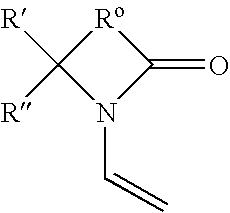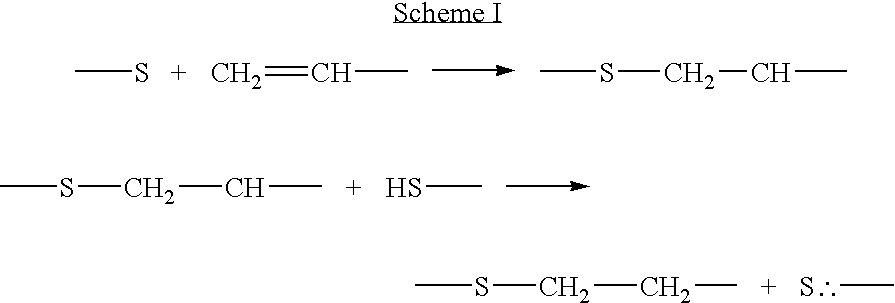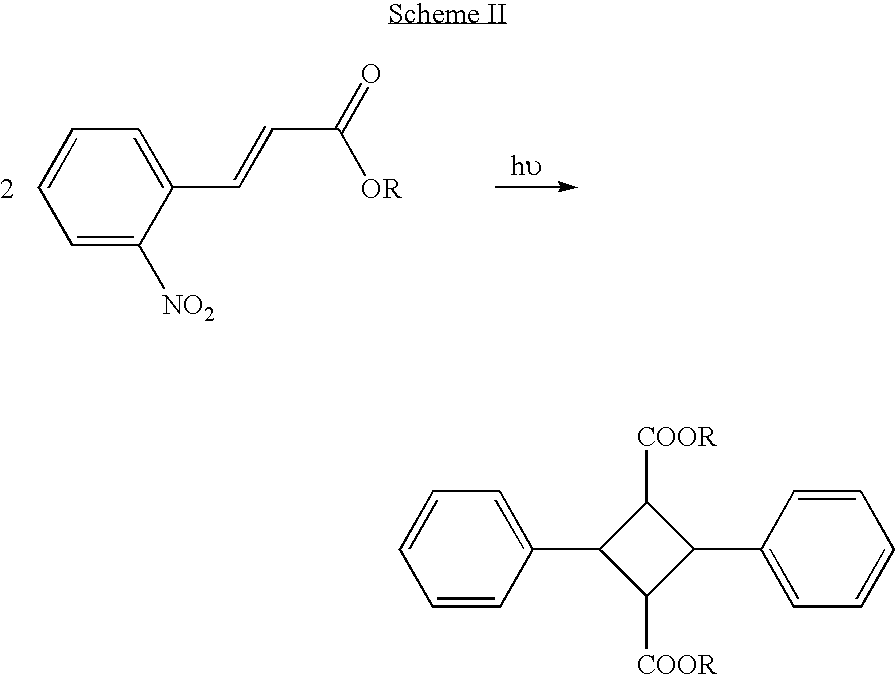Production of ophthalmic devices based on photo-induced step growth polymerization
a technology of photo-induced step growth and ophthalmic devices, which is applied in the field of production of ophthalmic devices, can solve the problems of slow cure process, hinder the realization of all of the great potentials of such technology, and molds may undergo non-uniform shrinkage, and achieve the effect of low viscosity
- Summary
- Abstract
- Description
- Claims
- Application Information
AI Technical Summary
Benefits of technology
Problems solved by technology
Method used
Image
Examples
example 1
Synthesis of Norbornene Carbonyl Chloride
[0164]A 500 mL sulfur flask was equipped with magnetic stirring, addition funnel, thermometer, reflux condenser with N2-inlet adapter, and outlet adapter connected to a trap immersed in a dry ice / acetone bath. 58.28 g of 2-norbornene-5-carboxylic acid (Aldrich) were charged to the reactor under a positive flow of nitrogen, then 31.4 mL of thionyl chloride (51.32 g). 450 mL of methyl-tert-butyl ether were added, an ice bath was applied, and the contents of the reactor were stirred to mix and cool to 3° C. 51.6 mL of triethylamine (37.45 g) and 20 mL of MTBE were charged to the addition funnel and added dropwise to keep temperature less than 10° C. On completion of the addition the ice bath was removed and the flask was stirred for one hour. The resulting suspension was filtered to remove triethylamine hydrochloride. The resulting clear yellow solution was reduced to an oil on a rotary evaporator and purified by fractional distillation at 8 mBa...
example 2
Synthesis of alpha-omega-diacrylamide Poly(dimethylsiloxane) 4500
[0165]In a 4-L beaker, 61.73 g of Na2CO3 (996 mEq), 80 g of NaCl and 1.52 kg of deionized water were mixed to dissolve. In a separate 4-L beaker, 700 g of alpha, omega-aminopropyl-polydimethylsiloaxane (Shin-Etsu manufacture, MW ca. 4500, 305 mEq) were dissolved in 1000 g of hexane. A 4-L reactor was equipped with overhead stirring with turbine agitator and a 250-mL addition funnel with micro-flow controller. The two solutions were then charged to the reactor, and mixed for 15 minutes with heavy agitation to produce an emulsion. 36.6 g of acryloyl chloride (405 mEq) was dissolved in 100 mL of hexane and charged to the addition funnel. The acryloyl chloride solution was added dropwise to the emulsion under heavy agitation over one hour. The emulsion was stirred for 30 minutes on completion of the addition and then agitation was stopped and the phases were allowed to separate overnight. The aqueous phase was decanted and...
example 3
Synthesis of alpha-omega-diacrylamide Poly(dimethylsiloxane) 2500
[0166]In a 4-L beaker, 111.1 g of Na2CO3 hydrate (1790 mEq), 80 g of NaCl and 1.52 kg of deionized water were mixed to dissolve. In a separate 4-L beaker, 700 g of alpha, omega-aminopropyl-polydimethylsiloaxane (Shin-Etsu manufacture, MW ca. 2500, 560 mEq) were dissolved in 1000 g of hexane. A 4-L reactor was equipped with overhead stirring with turbine agitator and a 250-mL addition funnel with micro-flow controller. The two solutions were then charged to the reactor, and mixed for 15 minutes with heavy agitation to produce an emulsion. 65.89 g of acryloyl chloride (728.1 mEq) was dissolved in 100 mL of hexane and charged to the addition funnel. The acryloyl chloride solution was added dropwise to the emulsion under heavy agitation over one hour. The emulsion was stirred for 30 minutes on completion of the addition and then agitation was stopped and the phases were allowed to separate overnight. The aqueous phase was ...
PUM
| Property | Measurement | Unit |
|---|---|---|
| Mass | aaaaa | aaaaa |
| Time | aaaaa | aaaaa |
| Time | aaaaa | aaaaa |
Abstract
Description
Claims
Application Information
 Login to View More
Login to View More - R&D
- Intellectual Property
- Life Sciences
- Materials
- Tech Scout
- Unparalleled Data Quality
- Higher Quality Content
- 60% Fewer Hallucinations
Browse by: Latest US Patents, China's latest patents, Technical Efficacy Thesaurus, Application Domain, Technology Topic, Popular Technical Reports.
© 2025 PatSnap. All rights reserved.Legal|Privacy policy|Modern Slavery Act Transparency Statement|Sitemap|About US| Contact US: help@patsnap.com



